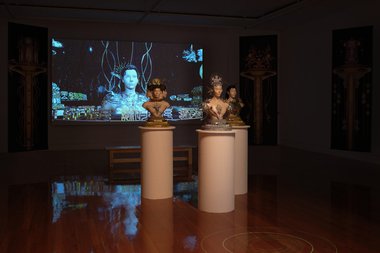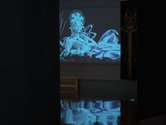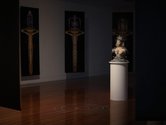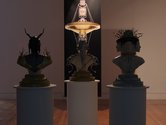John Hurrell – 8 January, 2023
The exhibition (while revelling in artifice and apparent ‘spiritual' pedagogy) seems to propose that a seductive image can only be a conceptual tool to help behavioural realisation, especially moral guidance for metempsychosis soul travel, a route for reincarnation, a means of correct living that goes beyond the fortuitous surface attraction of any deity.
Pakuranga
Xi Li
The Transcendence Labyrinth of Idols
Curated by Andrew Kennedy
4 December 2022 - 29 January 2023
An installation of eleven banners, three 3D printed sculptures, two moving (projected) circular floor diagrams and (on the end wall) a digitally animated video loop that in the large Te Tuhi gallery presents a hyper-real blemish-free world, this show indicates Whitecliffe & Elam graduate Xi Li‘s connection to other gifted NZ multi media artists like Sorawit Songsataya, Jess Johnson, Greg Bennett and Hye Rim Lee. Like many of these, Xi Li likes to incorporate 3D printed sculpture.
The revolving circular diagrams explore the construction of the Self, its connecting symbols, different types of Otherness, and types of desire, delusion and space. Three mandala-like variations alternate on two spots on the floor, some with counter-revolving diameter-traversing arms.
Depicting a layered mazelike garden of cosmological symbols in the form of columns, pools, statues of androgynous gods, rock formations and shrubs, the exhibition title refers to the three tendril-covered busts—that serve as knowledge aids—as ‘idols’ designed to be pathways, conduits or ladders leading to enlightenment. ‘Transcendence’ as a noun here functions as an adjective.
Stylistically these forms blend a smooth video game or ‘Hollywood’ look with that of Vajrayana or Zen Buddhism—with their arm gestures, reclining poses, rocks and pools, eroticism and dancing. On the other hand, the flat floor-to-ceiling banners (each one a distinctive decorative, motif-loaded column) are mostly shrouded in darkness. They seem lacklustre, due to their intrinsic lack of 3D plasticity, though that production decision may be conceptually and not economically driven.
The exhibition (while revelling in artifice and apparent ‘spiritual’ pedagogy) seems to propose that a seductive image is only be a conceptual tool that is never to be held on to; a temporary aid that goes beyond the shiny surface attraction of any artifact symbolising a guiding deity.
Looking again at the show’s title, the message appears to be what is important here, so beware of loving the messenger. Maybe though, one should be wary of the message as well—as a possible secondary meaning. The whole production seems deliberately twitchy and extremely reticent about authenticity or any claimed access to ultimate wisdom, perhaps denying its possibility.
You might argue this complicated show is an attack on celebrity culture, the fetishisation of youthful beauty, and vacuous fame in the mass media, digital or otherwise—but its ambience is too close to mysticism and established institutionalised religion for that. It seems earnest. Its crosshairs seem directed at much much older traditions.
John Hurrell










 Advertising in this column
Advertising in this column Two Rooms presents a program of residencies and projects
Two Rooms presents a program of residencies and projects



This Discussion has 0 comments.
Comment
Participate
Register to Participate.
Sign in
Sign in to an existing account.